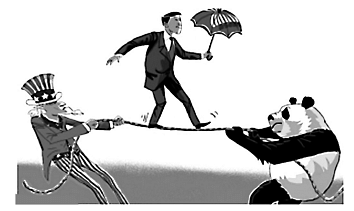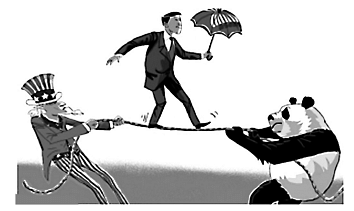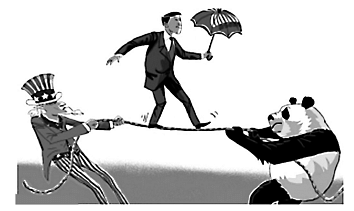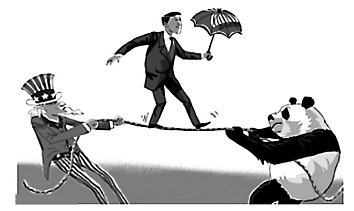Test: Contemporary Centres of Power- Case Based Type Questions - Humanities/Arts MCQ
16 Questions MCQ Test Political Science Class 12 - Test: Contemporary Centres of Power- Case Based Type Questions
Study the cartoon carefully and give the answers to the question that follows:

Q. Why is it difficult to maintain balance in the contemporary world?

Study the cartoon carefully and give the answers to the question that follows:

Q. Name the countries that are causing instability to the above organization and why?

| 1 Crore+ students have signed up on EduRev. Have you? Download the App |
Study the cartoon carefully and give the answers to the question that follows:

Q. Which organization walks on a tightrope in the above picture?

Study the cartoon carefully and give the answers to the question that follows:

Q. Write any one challenge this organization is facing?
Read the following paragraph and answer the questions that follow:
Under the Marshall Plan, the Organisation for European Economic Cooperation (OEEC) was established in 1948 to channel aid to the west European states. It became a forum where the western European states began to cooperate on trade and economic issues. The Council of Europe, established in 1949, was another step forward in political cooperation. The process of economic integration of European capitalist countries proceeded step by step (see Time-line of European Integration) leading to the formation of the European Economic Community in 1957. This process acquired a political dimension with the creation of the European Parliament. The collapse of the Soviet bloc put Europe on a fast track and resulted in the establishment of the European Union in 1992. The foundation was thus laid for a common foreign and security policy, cooperation on justice and home affairs, and the creation of a single currency. The European Union has evolved over time from an economic union to an increasingly political one. The EU has started to act more as a nation state. While the attempts to have a Constitution for the EU have failed, it has its own flag, anthem, founding date, and currency. The EU has economic, political and diplomatic, and military influence. The EU is the world’s second biggest economy with a GDP of more than $17 trillion in 2016, next to that of the United States of America. Its currency, the euro, can pose a threat to the dominance of the US dollar. Its share of world trade is much larger than that of the United States allowing it to be more assertive in trade disputes with the US and China. Its economic power gives it influence over its closest neighbours as well as in Asia and Africa.
Q. After OEEC, what was another step forward to achieve political cooperation in Europe?
Read the following paragraph and answer the questions that follow:
Under the Marshall Plan, the Organisation for European Economic Cooperation (OEEC) was established in 1948 to channel aid to the west European states. It became a forum where the western European states began to cooperate on trade and economic issues. The Council of Europe, established in 1949, was another step forward in political cooperation. The process of economic integration of European capitalist countries proceeded step by step (see Time-line of European Integration) leading to the formation of the European Economic Community in 1957. This process acquired a political dimension with the creation of the European Parliament. The collapse of the Soviet bloc put Europe on a fast track and resulted in the establishment of the European Union in 1992. The foundation was thus laid for a common foreign and security policy, cooperation on justice and home affairs, and the creation of a single currency. The European Union has evolved over time from an economic union to an increasingly political one. The EU has started to act more as a nation state. While the attempts to have a Constitution for the EU have failed, it has its own flag, anthem, founding date, and currency. The EU has economic, political and diplomatic, and military influence. The EU is the world’s second biggest economy with a GDP of more than $17 trillion in 2016, next to that of the United States of America. Its currency, the euro, can pose a threat to the dominance of the US dollar. Its share of world trade is much larger than that of the United States allowing it to be more assertive in trade disputes with the US and China. Its economic power gives it influence over its closest neighbours as well as in Asia and Africa.
Q. What was the GDP of European Union in 2016?
Read the following paragraph and answer the questions that follow:
Under the Marshall Plan, the Organisation for European Economic Cooperation (OEEC) was established in 1948 to channel aid to the west European states. It became a forum where the western European states began to cooperate on trade and economic issues. The Council of Europe, established in 1949, was another step forward in political cooperation. The process of economic integration of European capitalist countries proceeded step by step (see Time-line of European Integration) leading to the formation of the European Economic Community in 1957. This process acquired a political dimension with the creation of the European Parliament. The collapse of the Soviet bloc put Europe on a fast track and resulted in the establishment of the European Union in 1992. The foundation was thus laid for a common foreign and security policy, cooperation on justice and home affairs, and the creation of a single currency. The European Union has evolved over time from an economic union to an increasingly political one. The EU has started to act more as a nation state. While the attempts to have a Constitution for the EU have failed, it has its own flag, anthem, founding date, and currency. The EU has economic, political and diplomatic, and military influence. The EU is the world’s second biggest economy with a GDP of more than $17 trillion in 2016, next to that of the United States of America. Its currency, the euro, can pose a threat to the dominance of the US dollar. Its share of world trade is much larger than that of the United States allowing it to be more assertive in trade disputes with the US and China. Its economic power gives it influence over its closest neighbours as well as in Asia and Africa.
Q. The OEEC was established in:
Read the following paragraph and answer the questions that follow:
Under the Marshall Plan, the Organisation for European Economic Cooperation (OEEC) was established in 1948 to channel aid to the west European states. It became a forum where the western European states began to cooperate on trade and economic issues. The Council of Europe, established in 1949, was another step forward in political cooperation. The process of economic integration of European capitalist countries proceeded step by step (see Time-line of European Integration) leading to the formation of the European Economic Community in 1957. This process acquired a political dimension with the creation of the European Parliament. The collapse of the Soviet bloc put Europe on a fast track and resulted in the establishment of the European Union in 1992. The foundation was thus laid for a common foreign and security policy, cooperation on justice and home affairs, and the creation of a single currency. The European Union has evolved over time from an economic union to an increasingly political one. The EU has started to act more as a nation state. While the attempts to have a Constitution for the EU have failed, it has its own flag, anthem, founding date, and currency. The EU has economic, political and diplomatic, and military influence. The EU is the world’s second biggest economy with a GDP of more than $17 trillion in 2016, next to that of the United States of America. Its currency, the euro, can pose a threat to the dominance of the US dollar. Its share of world trade is much larger than that of the United States allowing it to be more assertive in trade disputes with the US and China. Its economic power gives it influence over its closest neighbours as well as in Asia and Africa.
Q. When was European Union formed?
Read the following paragraph and answer the questions that follow:
ASEAN was established in 1967 by five countries of this region — Indonesia, Malaysia, the Philippines, Singapore and Thailand — by signing the Bangkok Declaration. The objectives of ASEAN were primarily to accelerate economic growth and through that ‘social progress and cultural development’. A secondary objective was to promote regional peace and stability based on the rule of law and the principles of the United Nations Charter. Over the years, Brunei Darussalam, Vietnam, Lao PDR, Myanmar (Burma) and Cambodia joined ASEAN taking its strength to ten. With some of the fastest growing economies in the world, ASEAN broadened its objectives beyond the economic and social spheres. In 2003, ASEAN moved along the path of the EU by agreeing to establish an ASEAN Community comprising three pillars, namely, the ASEAN Security Community, the ASEAN Economic Community and the ASEAN Socio-Cultural Community. The ASEAN Regional Forum (ARF), which was established in 1994, is the organisation that carries out coordination of security and foreign policy.
Q. What was the objective of ASEAN?
Read the following paragraph and answer the questions that follow:
ASEAN was established in 1967 by five countries of this region — Indonesia, Malaysia, the Philippines, Singapore and Thailand — by signing the Bangkok Declaration. The objectives of ASEAN were primarily to accelerate economic growth and through that ‘social progress and cultural development’. A secondary objective was to promote regional peace and stability based on the rule of law and the principles of the United Nations Charter. Over the years, Brunei Darussalam, Vietnam, Lao PDR, Myanmar (Burma) and Cambodia joined ASEAN taking its strength to ten. With some of the fastest growing economies in the world, ASEAN broadened its objectives beyond the economic and social spheres. In 2003, ASEAN moved along the path of the EU by agreeing to establish an ASEAN Community comprising three pillars, namely, the ASEAN Security Community, the ASEAN Economic Community and the ASEAN Socio-Cultural Community. The ASEAN Regional Forum (ARF), which was established in 1994, is the organisation that carries out coordination of security and foreign policy.
Q. When the ARF was established?
Read the following paragraph and answer the questions that follow:
ASEAN was established in 1967 by five countries of this region — Indonesia, Malaysia, the Philippines, Singapore and Thailand — by signing the Bangkok Declaration. The objectives of ASEAN were primarily to accelerate economic growth and through that ‘social progress and cultural development’. A secondary objective was to promote regional peace and stability based on the rule of law and the principles of the United Nations Charter. Over the years, Brunei Darussalam, Vietnam, Lao PDR, Myanmar (Burma) and Cambodia joined ASEAN taking its strength to ten. With some of the fastest growing economies in the world, ASEAN broadened its objectives beyond the economic and social spheres. In 2003, ASEAN moved along the path of the EU by agreeing to establish an ASEAN Community comprising three pillars, namely, the ASEAN Security Community, the ASEAN Economic Community and the ASEAN Socio-Cultural Community. The ASEAN Regional Forum (ARF), which was established in 1994, is the organisation that carries out coordination of security and foreign policy.
Q. In 1967, when AESAN was established, which countries were its members?
Read the following paragraph and answer the questions that follow:
ASEAN was established in 1967 by five countries of this region — Indonesia, Malaysia, the Philippines, Singapore and Thailand — by signing the Bangkok Declaration. The objectives of ASEAN were primarily to accelerate economic growth and through that ‘social progress and cultural development’. A secondary objective was to promote regional peace and stability based on the rule of law and the principles of the United Nations Charter. Over the years, Brunei Darussalam, Vietnam, Lao PDR, Myanmar (Burma) and Cambodia joined ASEAN taking its strength to ten. With some of the fastest growing economies in the world, ASEAN broadened its objectives beyond the economic and social spheres. In 2003, ASEAN moved along the path of the EU by agreeing to establish an ASEAN Community comprising three pillars, namely, the ASEAN Security Community, the ASEAN Economic Community and the ASEAN Socio-Cultural Community. The ASEAN Regional Forum (ARF), which was established in 1994, is the organisation that carries out coordination of security and foreign policy.
Q. When did ASEAN start moving along the path of EU?
Read the following paragraph and answer the questions that follow:
On 1 April, 1950, India became the first nonsocialist bloc country to establish diplomatic relations with the People’s Republic of China. Prime Minister Nehru visited China in October 1954. While, the India-China border conflict in 1962 was a serious setback to ties, Prime Minister Rajiv Gandhi’s landmark visit in 1988 began a phase of improvement in bilateral relations. In 1993, the signing of an Agreement on the Maintenance of Peace and Tranquillity along the Line of Actual Control (LAC) on the India-China Border Areas during Prime Minister Narasimha Rao’s visit reflected the growing stability and substance in bilateral ties. Cumulative outcomes of the recent high level visits have been transformational for our ties. During Prime Minister Atal Bihari Vajpayee’s visit in 2003, India and China signed a Declaration on Principles for Relations and Comprehensive Cooperation and also mutually decided to appoint Special Representatives (SRs) to explore the framework of a boundary settlement from the political perspective. During the April 2005 visit of Premier Wen Jiabao, the two sides established a Strategic and Cooperative Partnership for Peace and Prosperity, while the signing of an agreement on Political Parameters and Guiding Principles signalled the successful conclusion of the first phase of SR Talks.
Q. Whose visit in 1988 began a phase of improvement in bilateral relations?
Read the following paragraph and answer the questions that follow:
On 1 April, 1950, India became the first nonsocialist bloc country to establish diplomatic relations with the People’s Republic of China. Prime Minister Nehru visited China in October 1954. While, the India-China border conflict in 1962 was a serious setback to ties, Prime Minister Rajiv Gandhi’s landmark visit in 1988 began a phase of improvement in bilateral relations. In 1993, the signing of an Agreement on the Maintenance of Peace and Tranquillity along the Line of Actual Control (LAC) on the India-China Border Areas during Prime Minister Narasimha Rao’s visit reflected the growing stability and substance in bilateral ties. Cumulative outcomes of the recent high level visits have been transformational for our ties. During Prime Minister Atal Bihari Vajpayee’s visit in 2003, India and China signed a Declaration on Principles for Relations and Comprehensive Cooperation and also mutually decided to appoint Special Representatives (SRs) to explore the framework of a boundary settlement from the political perspective. During the April 2005 visit of Premier Wen Jiabao, the two sides established a Strategic and Cooperative Partnership for Peace and Prosperity, while the signing of an agreement on Political Parameters and Guiding Principles, signalled the successful conclusion of the first phase of SR Talks.
Q. Who visited India in 2005 for the first phase of SR Talks?
Read the following paragraph and answer the questions that follow:
On 1 April, 1950, India became the first nonsocialist bloc country to establish diplomatic relations with the People’s Republic of China. Prime Minister Nehru visited China in October 1954. While, the India-China border conflict in 1962 was a serious setback to ties, Prime Minister Rajiv Gandhi’s landmark visit in 1988 began a phase of improvement in bilateral relations. In 1993, the signing of an Agreement on the Maintenance of Peace and Tranquillity along the Line of Actual Control (LAC) on the India-China Border Areas during Prime Minister Narasimha Rao’s visit reflected the growing stability and substance in bilateral ties. Cumulative outcomes of the recent high level visits have been transformational for our ties. During Prime Minister Atal Bihari Vajpayee’s visit in 2003, India and China signed a Declaration on Principles for Relations and Comprehensive Cooperation and also mutually decided to appoint Special Representatives (SRs) to explore the framework of a boundary settlement from the political perspective. During the April 2005 visit of Premier Wen Jiabao, the two sides established a Strategic and Cooperative Partnership for Peace and Prosperity, while the signing of an agreement on Political Parameters and Guiding Principles, signalled the successful conclusion of the first phase of SR Talks.
Q. When did India and China establish their diplomatic relations?
Read the following paragraph and answer the questions that follow:
On 1 April, 1950, India became the first nonsocialist bloc country to establish diplomatic relations with the People’s Republic of China. Prime Minister Nehru visited China in October 1954. While, the India-China border conflict in 1962 was a serious setback to ties, Prime Minister Rajiv Gandhi’s landmark visit in 1988 began a phase of improvement in bilateral relations. In 1993, the signing of an Agreement on the Maintenance of Peace and Tranquillity along the Line of Actual Control (LAC) on the India-China Border Areas during Prime Minister Narasimha Rao’s visit reflected the growing stability and substance in bilateral ties. Cumulative outcomes of the recent high level visits have been transformational for our ties. During Prime Minister Atal Bihari Vajpayee’s visit in 2003, India and China signed a Declaration on Principles for Relations and Comprehensive Cooperation and also mutually decided to appoint Special Representatives (SRs) to explore the framework of a boundary settlement from the political perspective. During the April 2005 visit of Premier Wen Jiabao, the two sides established a Strategic and Cooperative Partnership for Peace and Prosperity, while the signing of an agreement on Political Parameters and Guiding Principles, signalled the successful conclusion of the first phase of SR Talks.
Q. When did India and China sign a Declaration on Principles for Relations and Comprehensive Cooperation?
|
34 videos|246 docs|52 tests
|
|
34 videos|246 docs|52 tests
|

















